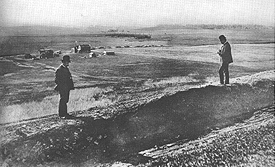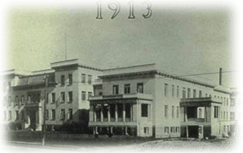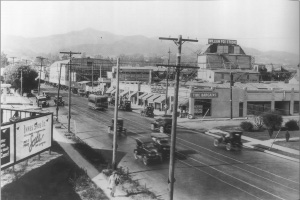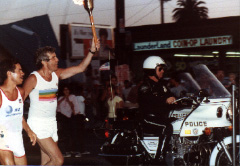 History History |
|||||||||
|
East Hollywood Neighborhood Council
|
East Hollywood History Early Days The first inhabitants of East Hollywood were the Cahug-Na Indians, who lived in the area spanning from modern-day Hollywood to Atwater Village. The Spanish settlers named them and their area "Cahuenga."
In 1887, just 37 years after California gained
statehood, a town named Prospect Park was
established to the east of the then-newly named rancho called Hollywood,
located some four miles northwest of Los Angeles.
By 1900, Hollywood was a farming village of
500 people. Crops also grew in nearby Prospect Park: oranges, avocados,
bananas, and wheat grew on the site of what is now Los Angeles City
College, and north toward the present Los Feliz area. Prospect
Park was renamed “East Hollywood” to more closely associate itself with
the booming town to the west which even then was on its way to legendary
status. In 1910, the people of the towns of Hollywood and East Hollywood voted to be annexed to the City of Los Angeles. Many other towns and communities at the time chose to join the growing city in order to have access to its water system, which had just opened the Los Angeles Aqueduct, piping in water from Owens Valley to the north. In the ‘Teens, East Hollywood, now a part of the growing city, started to develop. In 1914, Childrens Hospital relocated to Vermont Avenue and Sunset Boulevard from downtown Los Angeles. In 1916, a branch of the Los Angeles Public Library – the Cahuenga Branch - was built with money donated by steel magnate Andrew Carnegie on Santa Monica Boulevard.
In 1917, the community was predominantly
white/Anglo-Saxon. Less than four percent of its residents were nonwhite
(mostly African-American or Japanese).
The Los Angeles Normal School, an
institution which trained teachers, was established along Vermont Avenue
in the ‘Teens. In 1919, the school was acquired by the University of
California Regents and was designated the “University of California,
Southern Branch.” In the early 1920s, Barnsdall Park was built. The Roaring ‘20s also became a time when the world came to East Hollywood. Halfway around the world, as the Bolsheviks established the Soviet Union, Russian immigrants who fled their motherland during the communist revolution came to East Hollywood. Survivors of the 1915 Armenian Genocide by the Turkish Ottoman Empire found their new home here, establishing our Armenian community. At the end of the ‘20s, the University of
California Southern Branch, seeing the need for a much larger campus,
relocated twelve miles west in a ranch named Westwood, and became
UCLA. The old campus then became Los Angeles Junior College, later renamed
Los Angeles City College. Despite the Great Depression in the early
1930s, a single-family home building boom was going on here in East
Hollywood – most of our homes were built during this period. East Hollywood was home to a
Japanese-American community dating back to the 'Teens. Centered around the
Melrose/Virgil area, businesses such as markets, florists/nurseries and
restaurants were present here. But suddenly, as Americans of Japanese
descent were relocated to internment camps during World War II, the
community vanished. Following the war, after being released from the
camps, most of them never returned here. The 1960s & 1970sWith the 1960’s, the neighborhood continued
to change. The area's white residents gradually moved to suburbs such as
the San Fernando Valley and Orange County. Blacks and new immigrants from
Asia and Latin America moved in. In 1970, 53.3 per cent
of area residents were either foreign-born or had foreign-born parents.
More than 25 per cent spoke Spanish as their native language; more than 20
per cent were Asians: Japanese Chinese, Filipinos, Koreans and Thai. There
was a stable Arab population and natives of Russia, France, Greece,
Hungary, and Poland. The black population comprised about 5 percent and
centered around the area directly adjacent to the Cahuenga library. Since then, there have been a large increase in Asians, especially Koreans and Filipinos. New immigrants from Russia, mainly Armenian and Jewish, also arrived. The Arab population has increased, while Armenians from Arabic-speaking countries were on the rise. The 1980s & 1990s There was relative prosperity in East
Hollywood during the 1980s -- more immigrant businesses sprang up, but at
the same time the consequences of economy also shifted things around. The
closure of the Ralphs supermarket on Santa Monica and Vermont was a great
loss to residents in the area, who had to go a few blocks farther for
their grocery needs. Banks also moved out of the area, due to mergers and
demographic shifts. And many negative signs of urbanization -- namely gang
violence, homelessness and increased traffic and pollution -- were more
evident in the '80s.
The 21st Century Do you have any pictures or memories of East Hollywood prior to the 1970s? Please share them with us via e-mail.
|
||||||||



